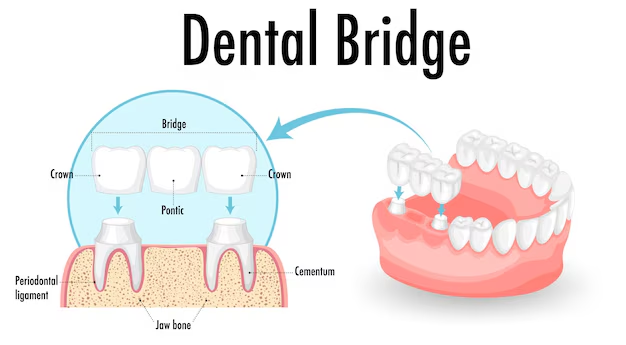Dental bridges are probably the most used and most reliable option for restoring missing teeth. In this age of technology, understanding the importance of the current dental bridges that are offered is helpful especially to persons like me who have tried several tooth replacement systems.At Dr. Gobran, we make it our mission to provide you with all the relevant information to help you choose the most suitable dental bridge. Here’s a guide to the different types of bridges and important factors you should consider.
1. Conventional Dental Bridges
These are the most widely used bridges and usually seek to replace a single missing tooth or multiple missing teeth. They comprise one or two pontics or more of artificial teeth that are attached on the dental crowns bonded onto some of the natural teeth surrounding the edentulous locus. This type of bridge has a good prognosis in retaining the functional and aesthetic value of the individual.
Advantages
· Provides a great turbine
· Offers both visual and practical rehabilitation
· Is employed in the case of several tooth loss.
Considerations:
· Adjacent teeth have to be pulled, prepared and crowned.
· Implant crowns should be considered if the teeth adjacent to the bridge are not adequate in strength to care for the bridge.
At DrGobran, we frequently advise traditional bridges for patients whose next healthy teeth require filling the gap – and persisting enhancers.
2. Cantilever Dental Bridges.
Cantilever bridges are used when there are teeth only on one side of the missing tooth or teeth. In this case, the pontic is attached to a crown on one side of the gap. This type of bridge is less common but often considered more aesthetically pleasing than the traditional type.
Advantages:
· Change in the left/right supporting natural teeth is less in comparison with conventional bridges.
· Applicable for gaps with support teeth on one side only.
Considerations:
· These bridges may not be as secure as the traditional ones.
· Larger gaps or locations exposed to heavy chewing efforts will not benefit from these shoots.
If you have a gap with only one adjacent tooth, Dr. Gobran would be pleased to check whether a cantilever bridge can serve this space acceptably.
3. Maryland Dental Bridges
Also known as resin-bonded bridges Maryland bridges is another type of dental – restorative prosthesis that does not require extensive intervention. It is simple, medically, and agreeable to patients and involves a structure made of both metal and porcelain with wings that are glued to the back of the neighboring teeth. Because of its little effect on the remaining supporting structures, this method of restoration is preferable in addressing the anterior teeth.
Advantages:
– Bestows maximum efficiency towards the preservation of the natural teeth.
– Less damaging procedure than traditional bridges.
– Cosmetic results are frequently very pleasing.
Considerations:
– May not be good enough to be used for back teeth or areas where there is a lot of chewing.
– They can only bond with healthy and sturdy neighboring structures.
Whenever it is possible to recommend Maryland bridges we still do it for patients who want a low-impact solution of missing a front tooth especially in cases where the aesthetic is a key factor.
4. Implant Supported Bridges
Implant-supported bridges is the newer approach, which nowadays includes placing dental implants into the jawbone to act as supports for the bridge. This type of bridge serves patients missing several teeth and having the tolerable bone density for supporting implants.
Advantages:
– Offers a more effective and probably longer-lasting solution when compared to the standard types of bridges.
– Assists in bone retention by encouraging bone tissue growth.
– No preparation of the adjacent teeth is necessary.
Considerations:
– It is an invasive treatment that requires surgery to place the implants.
– Usually comports protracted recovery period and more expenses.
DrGobran centres on implant-supported bridges for those who have lost a number of teeth and want a reliable and long-term alternative to natural teeth in both function and looks.
5. Fixed Partial Dentures
Fixed partial dentures also known as, unilateral dental prostheses bear similarity to traditional dental bridges only that they are very often used to replace a huge number of missing teeth. These consist in one or several prosthetic teeth fixed to a crown placed on the adjacent natural teeth or on tooth implants.
Advantages:
· Works very well in cases where several adjacent teeth are missing
· Offers good functional and occlusal support
Considerations:
· Adjacent teeth or implants are needed for retention which is relatively less invasive
· Modification of a healthy tooth structure in order to support prosthesis can be more difficult
This is a safe, functional and aesthetic burden for the patients at DrGobran as we can design and place fixed partial dentures for greater extent of your smile design.
Each type of dental bridge has its own specifications making it significant for dental professionals and patients to differentiate amongst them. There are benefits and considerations related to the utilization of each type of bridge and those depend on the location of the adjacent missing teeth, the condition of other teeth, and the general oral health of the patient. At DrGobran, we are ready to assist you in selecting the correct type of bridge, which will provide you with comfort as well as restore your dental aesthetics. In case you have any doubts or wish to book an appointment to know which option is best suited for you, please ensure that you reach out to us. We will be happy to assist you in taking the most beautiful and functional smile!


